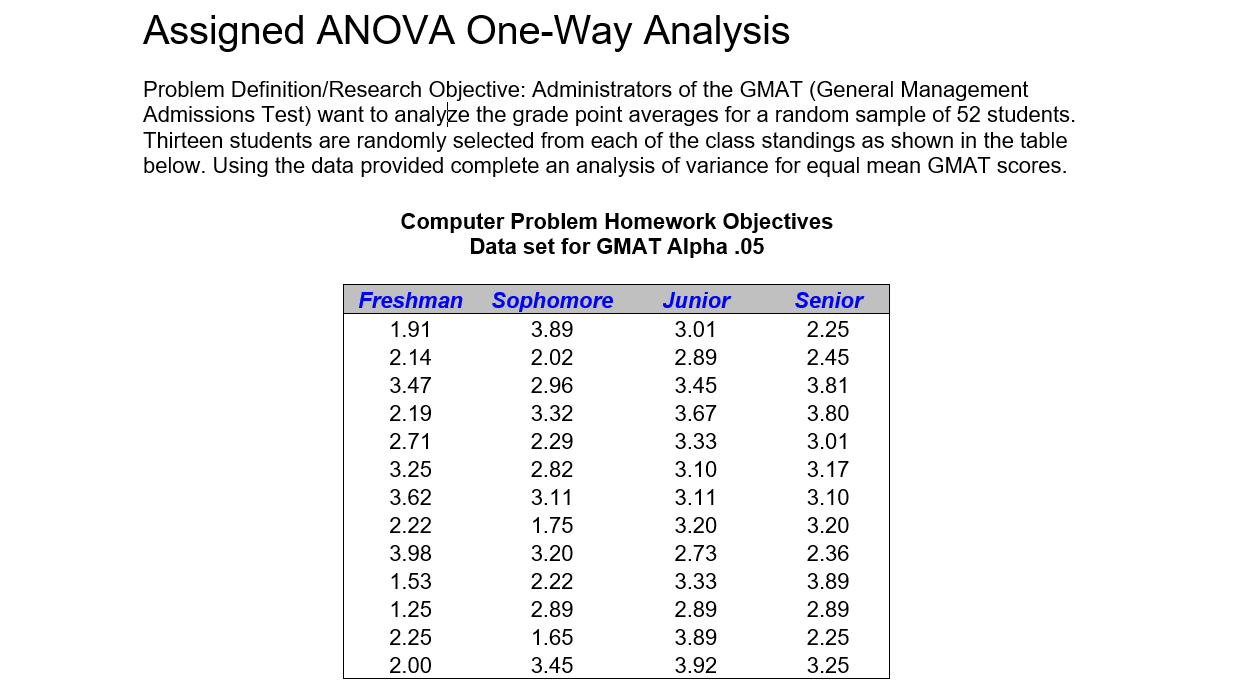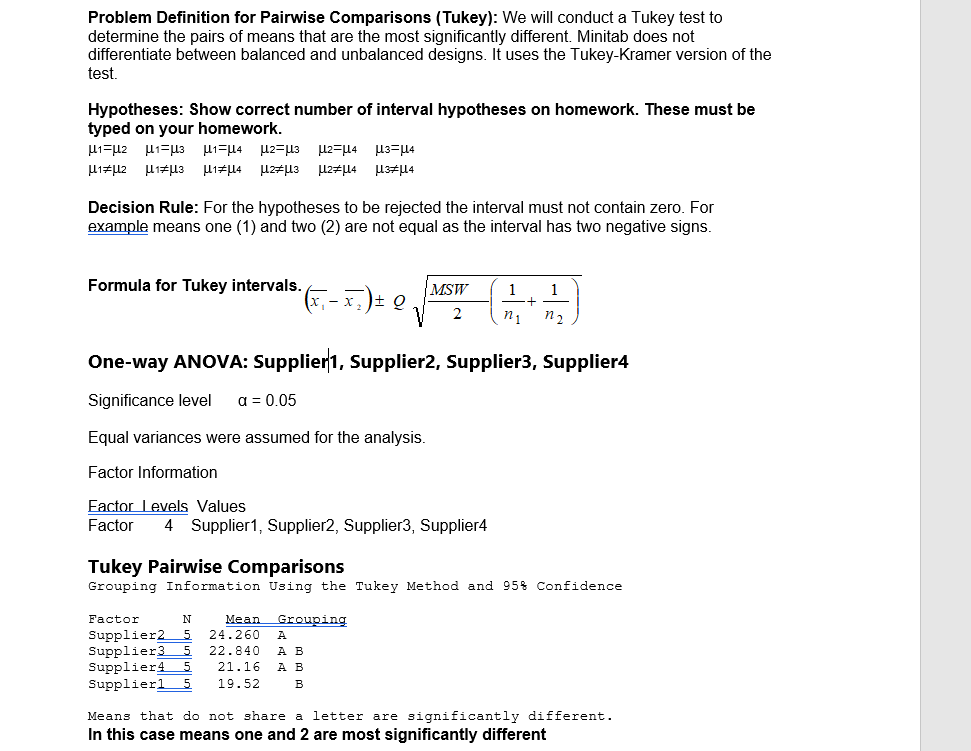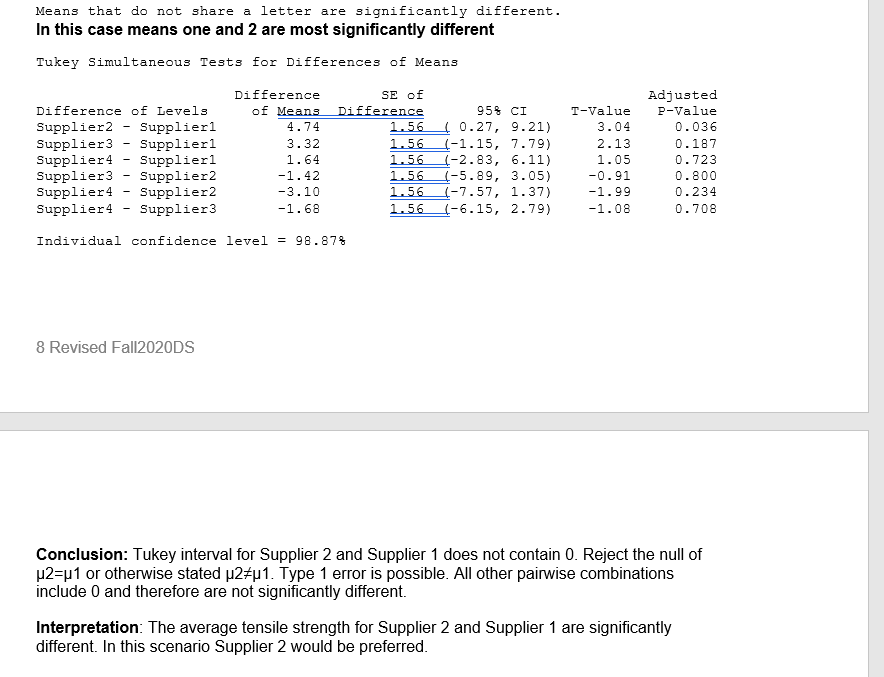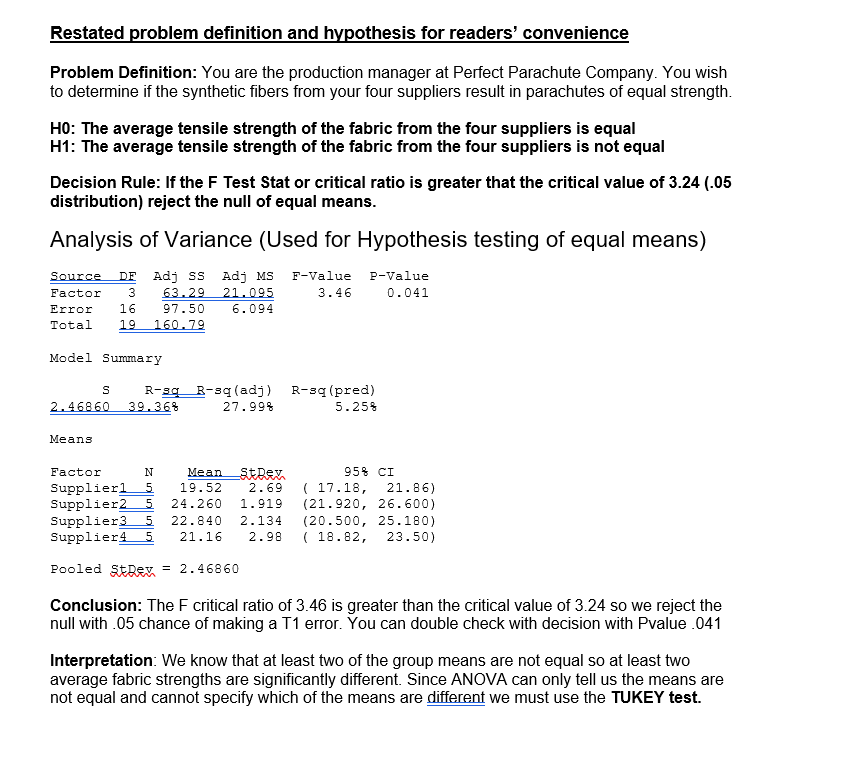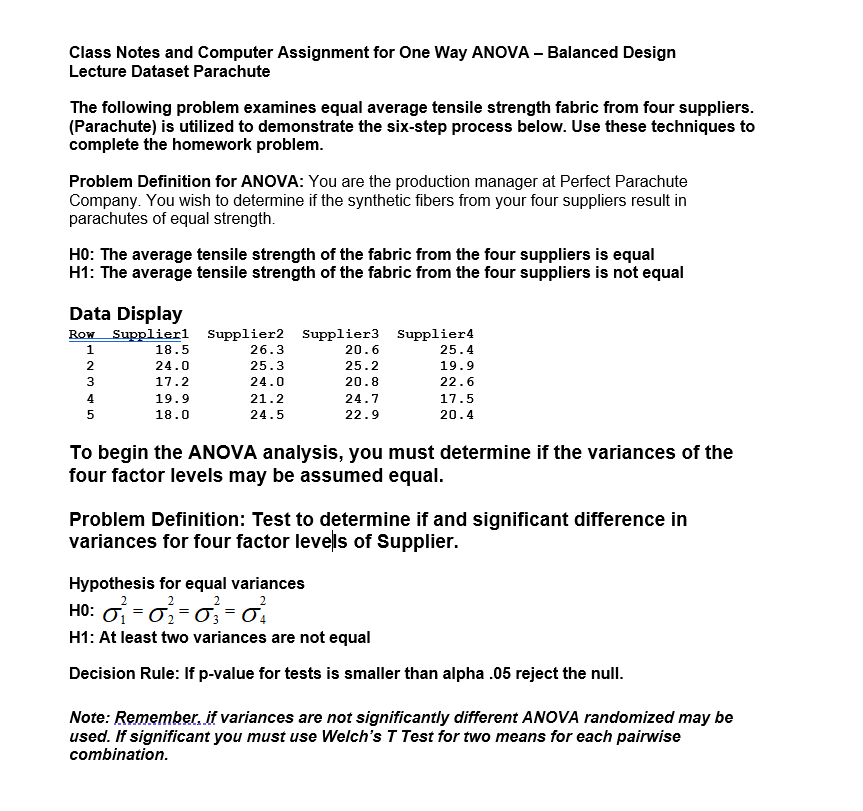This is a six-step hypothesis process problem. You must put the problem in both the six-step process and show the problem test steps in minitab!!!! Please read the entire pronblem and hypothesis test step order 1 problem defintion 2 Hypotheisis 3 Descion rule 4 Test (where mintab steps belong 5 conlcusion 6 interpratation 7 assumptions if relevant
Assigned ANOVA One-Way Analysis Problem DenitioniResearch Objective: Administrators of the GMAT (General Management Admissions Test) want to analylze the grade point averages for a random sample of 52 students. Thirteen students are randomly selected from each of the class standings as shown in the table below. Using the data provided complete an analysis of variance for equal mean GMAT scores. Computer Problem Homework Objectives Data set for GMAT Alpha .05 1.91 3.89 3.01 2.25 2.14 2.02 2.89 2.45 3.47 2.96 3.45 3.81 2.19 3.32 3.67 3.80 2.71 2.29 3.33 3.01 3.25 2.82 3.10 3.17 3.62 3.11 3.11 3.10 2.22 1.75 3.20 3.20 3.98 3.20 2.73 2.36 1.53 2.22 3.33 3.89 1.25 2.89 2.89 2.89 2.25 1.65 3.89 2.25 2.00 3.45 3.92 3.25 Problem Definition for Pairwise Comparisons (Tukey): We will conduct a Tukey test to determine the pairs of means that are the most significantly different. Minitab does not differentiate between balanced and unbalanced designs. It uses the Tukey-Kramer version of the test Hypotheses: Show correct number of interval hypotheses on homework. These must be typed on your homework. (1=U2 1=13 1=14 12=13 2=14 13=114 Decision Rule: For the hypotheses to be rejected the interval must not contain zero. For example means one (1) and two (2) are not equal as the interval has two negative signs. Formula for Tukey intervals. (x , - X2 ) + 9 MSW 2 n1 n 2 One-way ANOVA: Supplier1, Supplier2, Supplier3, Supplier4 Significance level a = 0.05 Equal variances were assumed for the analysis. Factor Information Eactor Levels Values Factor 4 Supplier1, Supplier2, Supplier3, Supplier4 Tukey Pairwise Comparisons Grouping Information Using the Tukey Method and 95% Confidence Factor Mean Grouping Supplier2 24.260 A Supplier3 22. 840 A B Supplier4 21 .16 A B Supplier1 19.52 Means that do not share a letter are significantly different. In this case means one and 2 are most significantly differentMeans that do not share a letter are significantly different. In this case means one and 2 are most significantly different Tukey Simultaneous Tests for Differences of Means Difference SE of Adjusted Difference of Levels of Means Difference 95% CI T-Value P-Value Supplier2 - Supplierl 4. 74 1. 56 ( 0. 27, 9.21) 3.04 0. 036 Supplier3 Supplierl 3.32 1. 56 (-1.15, 7.79) 2.13 0 . 187 Supplier4 Supplierl 1 . 64 1.56 (-2. 83, 6.11) 1. 05 0. 723 Supplier3 Supplier2 -1 . 42 1. 56 (-5. 89, 3.05) -0. 91 0 . 800 Supplier4 Supplier2 -3.10 1. 56 (-7.57, 1.37) -1.99 0.234 Supplier4 - Supplier3 -1.68 1. 56 4-6.15, 2.79) -1.08 0. 708 Individual confidence level = 98.873 8 Revised Fall2020DS Conclusion: Tukey interval for Supplier 2 and Supplier 1 does not contain 0. Reject the null of 12=1 or otherwise stated u2#p1. Type 1 error is possible. All other pairwise combinations include 0 and therefore are not significantly different. Interpretation: The average tensile strength for Supplier 2 and Supplier 1 are significantly different. In this scenario Supplier 2 would be preferred.Restated groblem denition and hypothesis for readers' convenience Problem Denition: You are the production manager at Perfect Parachute Company. You wish to determine if the synthetic bers from your four suppliers result in parachutes of equal strength. H0: The average tensile strength of the fabric from the four suppliers is equal H1: The average tensile strength of the fabric from the four suppliers is not equal Decision Rule: If the F Test Stat or critical ratio is greater that the critical value of 3.24 [.05 distribution} reject the null of equal means. Analysis of Variance {Used for Hypothesis testing of equal means) Snng__DE Adj SS Adj MS F-Value P-Value Factor 3 63.29 2 .IEE 3.46 0.041 Error 16 97.50 6.094 Total 9 I60.ES Model Summary 5 R-gg 3-sq[adj} R-sq[predl 2.5536\" 39.36% 27.99% 5.25% Nhana Factor N MeanW 95% CI Supplierl 5 19.52 2.69 [ 1T.18, 21.06) Supplier2 5 24.260 1.919 [21.920, 26.600) SupplierB 5 22.840 2.134 (20.500, 25.190) Supplier 5 21.16 2.90 [ 13.82, 23.50) Pooled 332; = 2.46360 Conclusion: The F critical ratio of 3.446 is greater than the critical value of 3.24 so we reject the null with .05 chance of making a T1 error. You can double check with decision with Pvalue .041 Interpretation: We know that at least two of the group means are not equal so at least two average fabric strengths are signicantly different. Since ANOVA can only tell us the means are not equal and cannot specify which of the means are different we must use the TUKEY test. Comparisons (Tukey test) One-Way Analysis of Variance: Comparisons X You must determine if Tukey test is needed (if reject null of Error rate for comparisons: 5 equal means). Comparison procedures assuming equal variances Tukey Fisher Dunnett Control group level: Supplier 1 Hsu MCB Best: Largest mean is best Results Interval plot for differences of means Grouping information Tests Help OK Cancel Resulting Boxplots Be sure to analyze each plot Boxplot of Supplier1, Supplier2, .. separately from the others. 26 Place these after equal variance test and describe each for normality assumption. (Yours will be for the assigned Data problem) 16- Supplier1 Supplier2 Supplier] Supplier4Class Notes and Computer Assignment for One Way ANOVA Balanced Design Lecture Dataset Parachute The following problem examines equal average tensile strength fabric from four suppliers. (Parachute) is utilized to demonstrate the six-step process below. Use these techniques to complete the homework problem. Problem Denition for ANOVA: You are the production manager at Perfect Parachute lCompany. You wish to determine if the synthetic bers from your tour suppliers result in parachutes of equal strength. H0: The average tensile strength of the fabric from the four suppliers is equal H1: The average tensile strength of the fabric from the four suppliers is not equal Data Display W1 Suppl 131:2 Suppl ier3 Suppl ierll 1 18.5 26.3 20.6 25.4 2 24.0 25.3 25.2 19.9 3 1?.2 24.0 20.8 22.6 4 19.9 21.2 24.? 1?.5 5 13.0 24.5 22.9 20.4 To begin the ANOVA analysis, you must determine if the variances of the four factor levels may be assumed equal. Problem Denition: Test to determine if and significant difference in variances for four factor levels of Supplier. Hypothesis for equal variances 2 2 2 2 H0501=Ug=03=04 H1: At least two variances are not equal Decision Rule: If p-value for tests is smaller than alpha .05 reject the null. Note: emgmberhif variances are not significantly different AND VA randomized may be used. if significant you must use Weicn's T Test for two means for each pairwise combination
